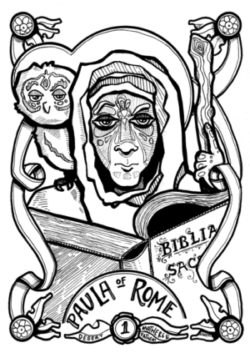December 3, 2015
Dance, Dance, Wherever you may Be
Spirituality
Lots of congregations sing “Lord of the Dance” on Sunday mornings, but really, what would most of them do if someone lost their inhibitions, took the song literally and began to “dance, dance,” right there in worship?
It is so rare to see a real outburst of spontaneous celebration of God’s Spirit in most established (especially white) churches that when it occurs we generally go in one of two directions. If we are inspired by it, we then want to control it ending up with predictable liturgical dancers—eyes and arms lifted toward heaven (in case we don’t understand that they are glorifying God)–or acceptable movement such as a little swaying and clapping. If we are embarrassed by it, we avert our eyes, ignore it and hope it goes away.
We could instead embrace it. Understand that we do not “have” bodies, we “are” bodies and sometimes those bodies want to move or otherwise express themselves in worship. We could, as they say, let the children, young adults and those with nothing to lose lead us toward a more embodied worship experience.
Embrace that Swing
Several years ago I had the privilege of working part-time at Southside Presbyterian Church in Tucson—one of the few multicultural progressive churches in Arizona. On this particular Sunday, children’s time had just ended, but, as was the custom at Southside, the children were not yet dismissed to their respective church school classrooms because the choir had not yet sung. With the children sitting on the flagstone floor of the Native American-style kiva sanctuary, the choir sang a rousing gospel rendition of the old favorite, “Love Lifted Me.”
In the middle of the song, with not a shred of inhibition, a six-year old girl leaps to her feet and starts free-form dancing. Now we’re all familiar with the one or two children in the church who enjoy making a scene during children’s time. But this little girl wasn’t in it for the attention. The motivation appeared to be pure adoration and praise. Most of the adults in the congregation were smiling—some had tears in their eyes—at the freedom the girl felt to “dance, dance, wherever she may be.”
When the song ended, the pastor, John Fife, stood to say, “That’s the difference between children and adults. She was inspired, so she got up and began dancing. Many of us were inspired as well, but we just sat there and let her dance all by herself!” Since then, when people at Southside feel so moved by the choir, they stand up and move.
That 6-year old dancer has a prophetic message for the larger church. On a base level, we have to understand how music moves the body and soul. I’m talking about music with full-bodied rhythm—and let’s be honest, most people just don’t feel like dancing to the pipe organ. Yes, saying that can start up a “worship war” in your congregation, but it doesn’t change the truth of the matter.
What this girl demonstrated was that if our churches want to be welcoming and attractive to people younger than your average church member, we had better be alive and ready for anything to happen in inspired worship.
(Which is why it thrilled me this past Sunday at First Congregational UCC Phoenix to turn around during a high-energy gospel song and see one of the young adults who was running the media center in the back moving and dancing to the music the way God intended! I only wish everyone there had turned around to see how much fun he was having at church.)
Embrace the Awkward Illustration
Sometimes spontaneity is thrust upon us by those who have long ago lost the usual societal inhibitions. I once visited a Presbyterian church in Albuquerque as a wild-haired, scruffy older man in a heavy coat had a burden to share in worship. Rising during announcement time, he proceeded to the pulpit to confess to a number of “sins of the flesh.” The young pastor appeared to know this man, and was not exactly surprised at the pop-up confession but was at a loss for what to do. So, he let the man speak.
As fate would have it, the sermon that morning—from the lectionary—was the parable of the Pharisee and the tax collector. Jesus saying that the one who “beat his breast” saying, “God, be merciful to me a sinner” was justified. What a brilliant sermon illustration! Unplanned and awkward, yes. But, frankly a bright spot in the liturgy.
Was this celebrated as a happy coincidence? Or even a Godly moment? Hardly. No mention is made of the event after the man is escorted away from the pulpit, because his interjection is seen as an embarrassing disturbance.
We’ll need to shed this self-consciousness and a desire to control if we want God’s spirit to blow around in worship. If something bizarre but meaningful happens in worship, let’s make the most of it. It sure beats the Easter Sunday I spent at a mainline church in the Bay area where I counted at least three people in their twenties fast asleep during the sermon.
Let’s embrace the crazy outburst as important data for discerning when and where God’s Spirit is moving within the congregation. How can we follow it more closely? How can we stay open to those times when worship goes slightly awry, seeing what those moments have to teach us? Savor them, in all their ickiness, and you’ll soon become more comfortable with the unusual, the ecstatic, the surprising.
Honoring the Body
Church leaders could start to honor the body in worship by incorporating call-and-response music, drums, incense and a variety of simple prayer postures. Make worship a feast of all five senses, not just the ear and eyes. Instead of bringing on the approved liturgical dancer why not go into the community and hire a professional contemporary dancer to do an original dance illustrating the theme of worship that day? Lift our eyes from the bulletin by posting what we need for worship on a screen or even an old-fashioned poster board up front. Leave us on the edge of our seats by writing sermons with cliff-hanger endings, like the serial dramas on TV do each week. Ask us to yell out “Amen” to your sermon when we feel it. And then entice us with God’s word so that we want to.
Making room for the spontaneous will not be easy for people set in their ways. It requires an attitude of hospitality that says whatever is done in authentic response to the Word or the Spirit is OK with us.
It requires being brave enough to admit that if our music, preaching and prayer aren’t filled with enough of God’s Spirit to move people in some pretty significant ways, we’re in trouble and need to plead for God’s mercy. Remember, boring people in worship is a sin.
The good news is that the Lord of the Dance is the one who saves us.




